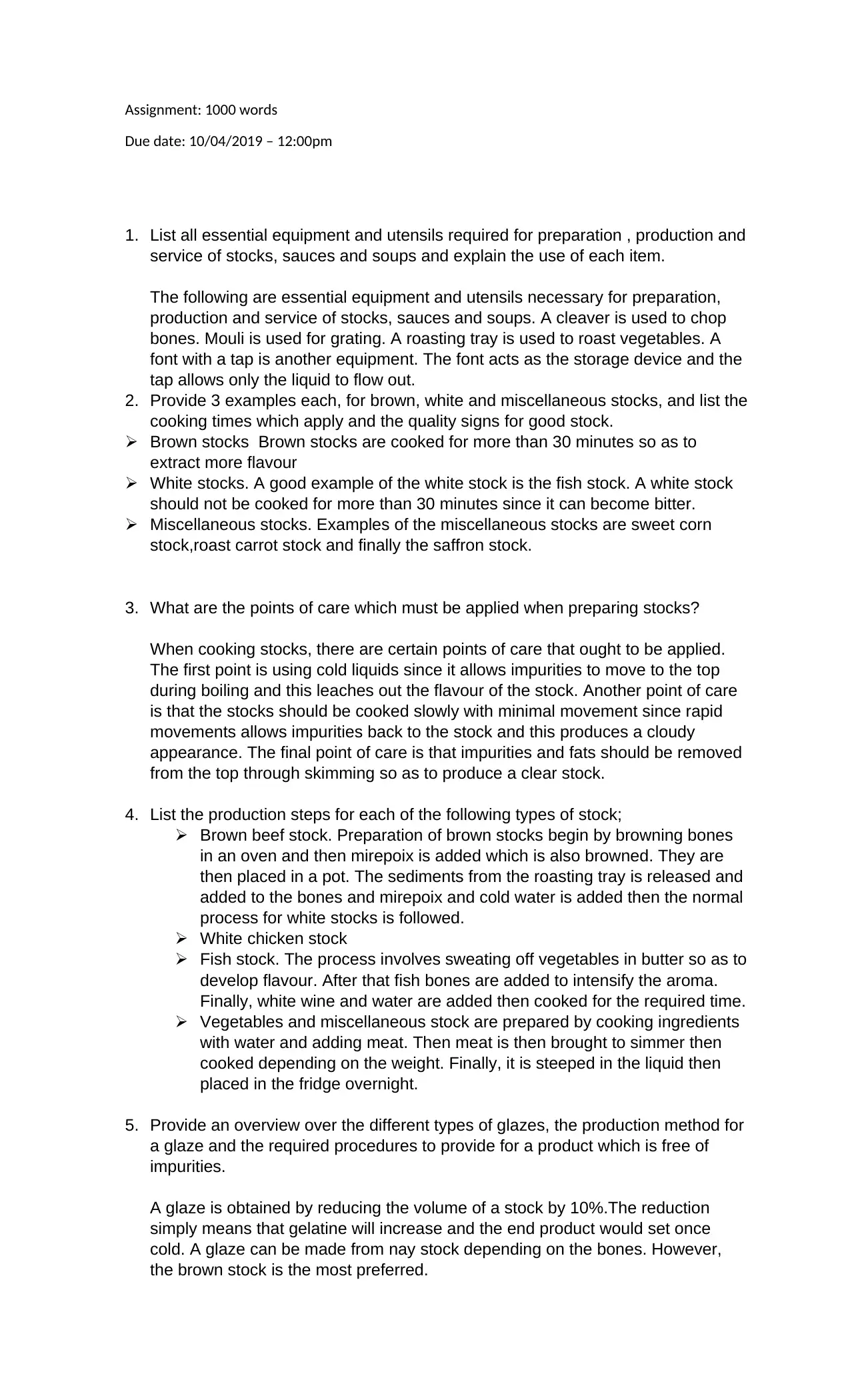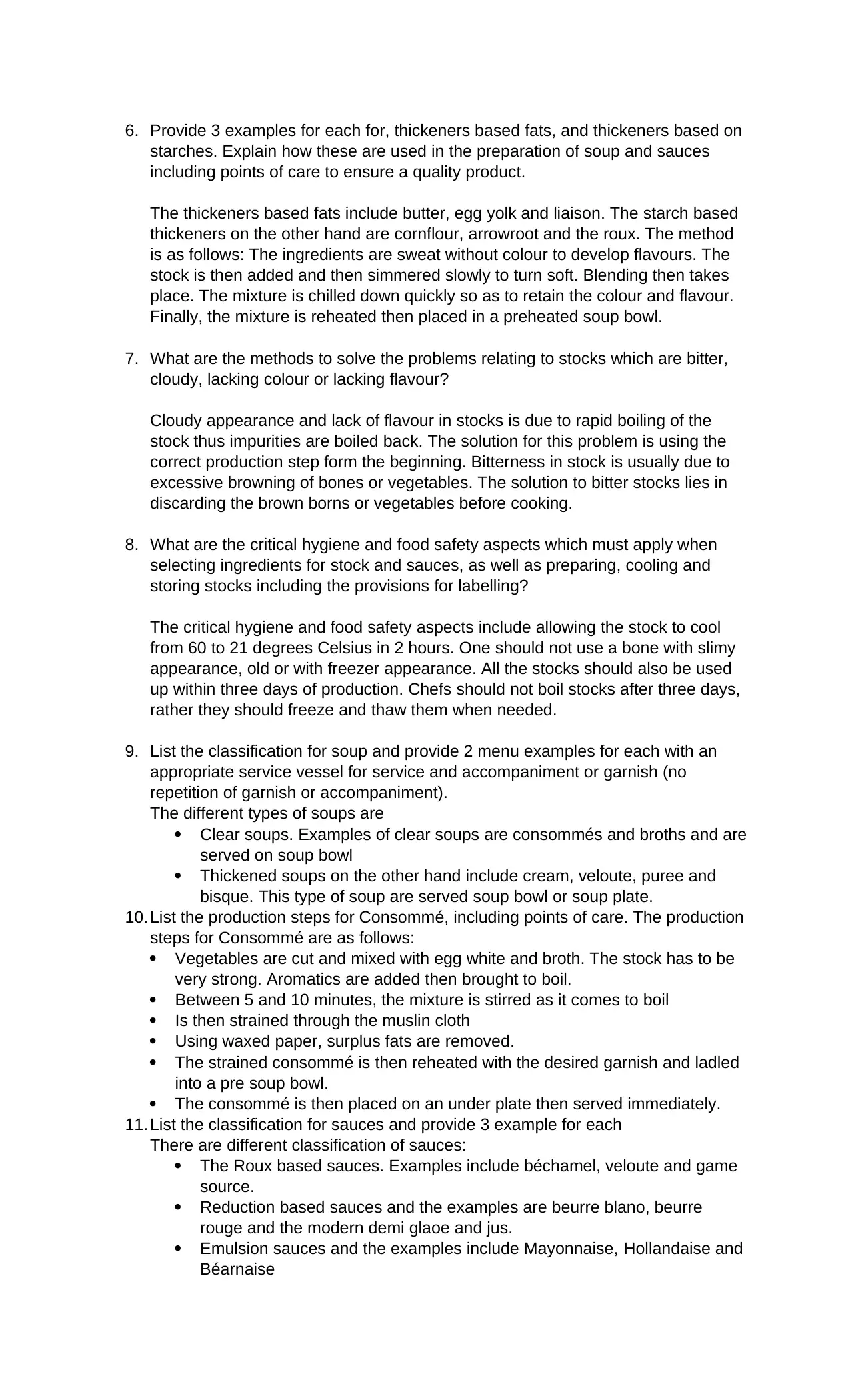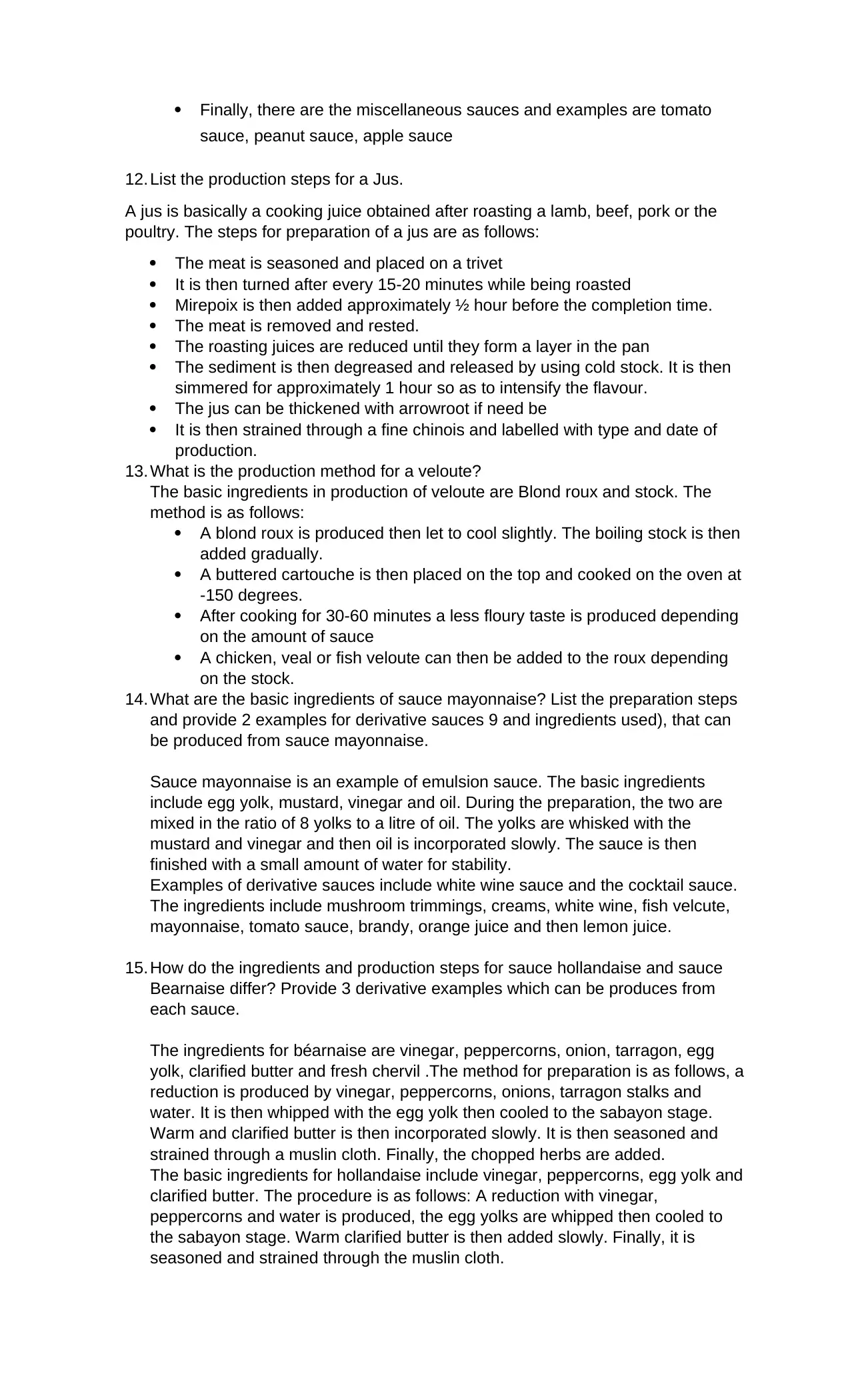Detailed Assignment: Preparing Stocks, Sauces, and Soups (SITHCCC007)
VerifiedAdded on 2023/01/18
|4
|1917
|32
Homework Assignment
AI Summary
This assignment comprehensively covers the preparation of stocks, sauces, and soups, essential components of professional kitchens. It details the necessary equipment and utensils, providing examples of brown, white, and miscellaneous stocks, along with their cooking times and quality indicators. The assignment explores crucial points of care during stock preparation, outlining production steps for various stock types like brown beef, white chicken, fish, and vegetable stocks. It also delves into glazes, thickeners (fats and starches), and methods to troubleshoot common stock issues such as bitterness and cloudiness. Furthermore, it emphasizes critical hygiene and food safety aspects, including ingredient selection, cooling, and storage. The assignment classifies soups, provides menu examples, and details the production steps for consommé. It also categorizes and provides examples of sauces, including roux-based, reduction-based, emulsion, and miscellaneous types, detailing the production steps for jus, veloute, mayonnaise, hollandaise, and béarnaise, while also covering derivative sauces and hygienic procedures for reconstitution.

Assignment: 1000 words
Due date: 10/04/2019 – 12:00pm
1. List all essential equipment and utensils required for preparation , production and
service of stocks, sauces and soups and explain the use of each item.
The following are essential equipment and utensils necessary for preparation,
production and service of stocks, sauces and soups. A cleaver is used to chop
bones. Mouli is used for grating. A roasting tray is used to roast vegetables. A
font with a tap is another equipment. The font acts as the storage device and the
tap allows only the liquid to flow out.
2. Provide 3 examples each, for brown, white and miscellaneous stocks, and list the
cooking times which apply and the quality signs for good stock.
Brown stocks Brown stocks are cooked for more than 30 minutes so as to
extract more flavour
White stocks. A good example of the white stock is the fish stock. A white stock
should not be cooked for more than 30 minutes since it can become bitter.
Miscellaneous stocks. Examples of the miscellaneous stocks are sweet corn
stock,roast carrot stock and finally the saffron stock.
3. What are the points of care which must be applied when preparing stocks?
When cooking stocks, there are certain points of care that ought to be applied.
The first point is using cold liquids since it allows impurities to move to the top
during boiling and this leaches out the flavour of the stock. Another point of care
is that the stocks should be cooked slowly with minimal movement since rapid
movements allows impurities back to the stock and this produces a cloudy
appearance. The final point of care is that impurities and fats should be removed
from the top through skimming so as to produce a clear stock.
4. List the production steps for each of the following types of stock;
Brown beef stock. Preparation of brown stocks begin by browning bones
in an oven and then mirepoix is added which is also browned. They are
then placed in a pot. The sediments from the roasting tray is released and
added to the bones and mirepoix and cold water is added then the normal
process for white stocks is followed.
White chicken stock
Fish stock. The process involves sweating off vegetables in butter so as to
develop flavour. After that fish bones are added to intensify the aroma.
Finally, white wine and water are added then cooked for the required time.
Vegetables and miscellaneous stock are prepared by cooking ingredients
with water and adding meat. Then meat is then brought to simmer then
cooked depending on the weight. Finally, it is steeped in the liquid then
placed in the fridge overnight.
5. Provide an overview over the different types of glazes, the production method for
a glaze and the required procedures to provide for a product which is free of
impurities.
A glaze is obtained by reducing the volume of a stock by 10%.The reduction
simply means that gelatine will increase and the end product would set once
cold. A glaze can be made from nay stock depending on the bones. However,
the brown stock is the most preferred.
Due date: 10/04/2019 – 12:00pm
1. List all essential equipment and utensils required for preparation , production and
service of stocks, sauces and soups and explain the use of each item.
The following are essential equipment and utensils necessary for preparation,
production and service of stocks, sauces and soups. A cleaver is used to chop
bones. Mouli is used for grating. A roasting tray is used to roast vegetables. A
font with a tap is another equipment. The font acts as the storage device and the
tap allows only the liquid to flow out.
2. Provide 3 examples each, for brown, white and miscellaneous stocks, and list the
cooking times which apply and the quality signs for good stock.
Brown stocks Brown stocks are cooked for more than 30 minutes so as to
extract more flavour
White stocks. A good example of the white stock is the fish stock. A white stock
should not be cooked for more than 30 minutes since it can become bitter.
Miscellaneous stocks. Examples of the miscellaneous stocks are sweet corn
stock,roast carrot stock and finally the saffron stock.
3. What are the points of care which must be applied when preparing stocks?
When cooking stocks, there are certain points of care that ought to be applied.
The first point is using cold liquids since it allows impurities to move to the top
during boiling and this leaches out the flavour of the stock. Another point of care
is that the stocks should be cooked slowly with minimal movement since rapid
movements allows impurities back to the stock and this produces a cloudy
appearance. The final point of care is that impurities and fats should be removed
from the top through skimming so as to produce a clear stock.
4. List the production steps for each of the following types of stock;
Brown beef stock. Preparation of brown stocks begin by browning bones
in an oven and then mirepoix is added which is also browned. They are
then placed in a pot. The sediments from the roasting tray is released and
added to the bones and mirepoix and cold water is added then the normal
process for white stocks is followed.
White chicken stock
Fish stock. The process involves sweating off vegetables in butter so as to
develop flavour. After that fish bones are added to intensify the aroma.
Finally, white wine and water are added then cooked for the required time.
Vegetables and miscellaneous stock are prepared by cooking ingredients
with water and adding meat. Then meat is then brought to simmer then
cooked depending on the weight. Finally, it is steeped in the liquid then
placed in the fridge overnight.
5. Provide an overview over the different types of glazes, the production method for
a glaze and the required procedures to provide for a product which is free of
impurities.
A glaze is obtained by reducing the volume of a stock by 10%.The reduction
simply means that gelatine will increase and the end product would set once
cold. A glaze can be made from nay stock depending on the bones. However,
the brown stock is the most preferred.
Paraphrase This Document
Need a fresh take? Get an instant paraphrase of this document with our AI Paraphraser

6. Provide 3 examples for each for, thickeners based fats, and thickeners based on
starches. Explain how these are used in the preparation of soup and sauces
including points of care to ensure a quality product.
The thickeners based fats include butter, egg yolk and liaison. The starch based
thickeners on the other hand are cornflour, arrowroot and the roux. The method
is as follows: The ingredients are sweat without colour to develop flavours. The
stock is then added and then simmered slowly to turn soft. Blending then takes
place. The mixture is chilled down quickly so as to retain the colour and flavour.
Finally, the mixture is reheated then placed in a preheated soup bowl.
7. What are the methods to solve the problems relating to stocks which are bitter,
cloudy, lacking colour or lacking flavour?
Cloudy appearance and lack of flavour in stocks is due to rapid boiling of the
stock thus impurities are boiled back. The solution for this problem is using the
correct production step form the beginning. Bitterness in stock is usually due to
excessive browning of bones or vegetables. The solution to bitter stocks lies in
discarding the brown borns or vegetables before cooking.
8. What are the critical hygiene and food safety aspects which must apply when
selecting ingredients for stock and sauces, as well as preparing, cooling and
storing stocks including the provisions for labelling?
The critical hygiene and food safety aspects include allowing the stock to cool
from 60 to 21 degrees Celsius in 2 hours. One should not use a bone with slimy
appearance, old or with freezer appearance. All the stocks should also be used
up within three days of production. Chefs should not boil stocks after three days,
rather they should freeze and thaw them when needed.
9. List the classification for soup and provide 2 menu examples for each with an
appropriate service vessel for service and accompaniment or garnish (no
repetition of garnish or accompaniment).
The different types of soups are
Clear soups. Examples of clear soups are consommés and broths and are
served on soup bowl
Thickened soups on the other hand include cream, veloute, puree and
bisque. This type of soup are served soup bowl or soup plate.
10. List the production steps for Consommé, including points of care. The production
steps for Consommé are as follows:
Vegetables are cut and mixed with egg white and broth. The stock has to be
very strong. Aromatics are added then brought to boil.
Between 5 and 10 minutes, the mixture is stirred as it comes to boil
Is then strained through the muslin cloth
Using waxed paper, surplus fats are removed.
The strained consommé is then reheated with the desired garnish and ladled
into a pre soup bowl.
The consommé is then placed on an under plate then served immediately.
11. List the classification for sauces and provide 3 example for each
There are different classification of sauces:
The Roux based sauces. Examples include béchamel, veloute and game
source.
Reduction based sauces and the examples are beurre blano, beurre
rouge and the modern demi glaoe and jus.
Emulsion sauces and the examples include Mayonnaise, Hollandaise and
Béarnaise
starches. Explain how these are used in the preparation of soup and sauces
including points of care to ensure a quality product.
The thickeners based fats include butter, egg yolk and liaison. The starch based
thickeners on the other hand are cornflour, arrowroot and the roux. The method
is as follows: The ingredients are sweat without colour to develop flavours. The
stock is then added and then simmered slowly to turn soft. Blending then takes
place. The mixture is chilled down quickly so as to retain the colour and flavour.
Finally, the mixture is reheated then placed in a preheated soup bowl.
7. What are the methods to solve the problems relating to stocks which are bitter,
cloudy, lacking colour or lacking flavour?
Cloudy appearance and lack of flavour in stocks is due to rapid boiling of the
stock thus impurities are boiled back. The solution for this problem is using the
correct production step form the beginning. Bitterness in stock is usually due to
excessive browning of bones or vegetables. The solution to bitter stocks lies in
discarding the brown borns or vegetables before cooking.
8. What are the critical hygiene and food safety aspects which must apply when
selecting ingredients for stock and sauces, as well as preparing, cooling and
storing stocks including the provisions for labelling?
The critical hygiene and food safety aspects include allowing the stock to cool
from 60 to 21 degrees Celsius in 2 hours. One should not use a bone with slimy
appearance, old or with freezer appearance. All the stocks should also be used
up within three days of production. Chefs should not boil stocks after three days,
rather they should freeze and thaw them when needed.
9. List the classification for soup and provide 2 menu examples for each with an
appropriate service vessel for service and accompaniment or garnish (no
repetition of garnish or accompaniment).
The different types of soups are
Clear soups. Examples of clear soups are consommés and broths and are
served on soup bowl
Thickened soups on the other hand include cream, veloute, puree and
bisque. This type of soup are served soup bowl or soup plate.
10. List the production steps for Consommé, including points of care. The production
steps for Consommé are as follows:
Vegetables are cut and mixed with egg white and broth. The stock has to be
very strong. Aromatics are added then brought to boil.
Between 5 and 10 minutes, the mixture is stirred as it comes to boil
Is then strained through the muslin cloth
Using waxed paper, surplus fats are removed.
The strained consommé is then reheated with the desired garnish and ladled
into a pre soup bowl.
The consommé is then placed on an under plate then served immediately.
11. List the classification for sauces and provide 3 example for each
There are different classification of sauces:
The Roux based sauces. Examples include béchamel, veloute and game
source.
Reduction based sauces and the examples are beurre blano, beurre
rouge and the modern demi glaoe and jus.
Emulsion sauces and the examples include Mayonnaise, Hollandaise and
Béarnaise

Finally, there are the miscellaneous sauces and examples are tomato
sauce, peanut sauce, apple sauce
12. List the production steps for a Jus.
A jus is basically a cooking juice obtained after roasting a lamb, beef, pork or the
poultry. The steps for preparation of a jus are as follows:
The meat is seasoned and placed on a trivet
It is then turned after every 15-20 minutes while being roasted
Mirepoix is then added approximately ½ hour before the completion time.
The meat is removed and rested.
The roasting juices are reduced until they form a layer in the pan
The sediment is then degreased and released by using cold stock. It is then
simmered for approximately 1 hour so as to intensify the flavour.
The jus can be thickened with arrowroot if need be
It is then strained through a fine chinois and labelled with type and date of
production.
13. What is the production method for a veloute?
The basic ingredients in production of veloute are Blond roux and stock. The
method is as follows:
A blond roux is produced then let to cool slightly. The boiling stock is then
added gradually.
A buttered cartouche is then placed on the top and cooked on the oven at
-150 degrees.
After cooking for 30-60 minutes a less floury taste is produced depending
on the amount of sauce
A chicken, veal or fish veloute can then be added to the roux depending
on the stock.
14. What are the basic ingredients of sauce mayonnaise? List the preparation steps
and provide 2 examples for derivative sauces 9 and ingredients used), that can
be produced from sauce mayonnaise.
Sauce mayonnaise is an example of emulsion sauce. The basic ingredients
include egg yolk, mustard, vinegar and oil. During the preparation, the two are
mixed in the ratio of 8 yolks to a litre of oil. The yolks are whisked with the
mustard and vinegar and then oil is incorporated slowly. The sauce is then
finished with a small amount of water for stability.
Examples of derivative sauces include white wine sauce and the cocktail sauce.
The ingredients include mushroom trimmings, creams, white wine, fish velcute,
mayonnaise, tomato sauce, brandy, orange juice and then lemon juice.
15. How do the ingredients and production steps for sauce hollandaise and sauce
Bearnaise differ? Provide 3 derivative examples which can be produces from
each sauce.
The ingredients for béarnaise are vinegar, peppercorns, onion, tarragon, egg
yolk, clarified butter and fresh chervil .The method for preparation is as follows, a
reduction is produced by vinegar, peppercorns, onions, tarragon stalks and
water. It is then whipped with the egg yolk then cooled to the sabayon stage.
Warm and clarified butter is then incorporated slowly. It is then seasoned and
strained through a muslin cloth. Finally, the chopped herbs are added.
The basic ingredients for hollandaise include vinegar, peppercorns, egg yolk and
clarified butter. The procedure is as follows: A reduction with vinegar,
peppercorns and water is produced, the egg yolks are whipped then cooled to
the sabayon stage. Warm clarified butter is then added slowly. Finally, it is
seasoned and strained through the muslin cloth.
sauce, peanut sauce, apple sauce
12. List the production steps for a Jus.
A jus is basically a cooking juice obtained after roasting a lamb, beef, pork or the
poultry. The steps for preparation of a jus are as follows:
The meat is seasoned and placed on a trivet
It is then turned after every 15-20 minutes while being roasted
Mirepoix is then added approximately ½ hour before the completion time.
The meat is removed and rested.
The roasting juices are reduced until they form a layer in the pan
The sediment is then degreased and released by using cold stock. It is then
simmered for approximately 1 hour so as to intensify the flavour.
The jus can be thickened with arrowroot if need be
It is then strained through a fine chinois and labelled with type and date of
production.
13. What is the production method for a veloute?
The basic ingredients in production of veloute are Blond roux and stock. The
method is as follows:
A blond roux is produced then let to cool slightly. The boiling stock is then
added gradually.
A buttered cartouche is then placed on the top and cooked on the oven at
-150 degrees.
After cooking for 30-60 minutes a less floury taste is produced depending
on the amount of sauce
A chicken, veal or fish veloute can then be added to the roux depending
on the stock.
14. What are the basic ingredients of sauce mayonnaise? List the preparation steps
and provide 2 examples for derivative sauces 9 and ingredients used), that can
be produced from sauce mayonnaise.
Sauce mayonnaise is an example of emulsion sauce. The basic ingredients
include egg yolk, mustard, vinegar and oil. During the preparation, the two are
mixed in the ratio of 8 yolks to a litre of oil. The yolks are whisked with the
mustard and vinegar and then oil is incorporated slowly. The sauce is then
finished with a small amount of water for stability.
Examples of derivative sauces include white wine sauce and the cocktail sauce.
The ingredients include mushroom trimmings, creams, white wine, fish velcute,
mayonnaise, tomato sauce, brandy, orange juice and then lemon juice.
15. How do the ingredients and production steps for sauce hollandaise and sauce
Bearnaise differ? Provide 3 derivative examples which can be produces from
each sauce.
The ingredients for béarnaise are vinegar, peppercorns, onion, tarragon, egg
yolk, clarified butter and fresh chervil .The method for preparation is as follows, a
reduction is produced by vinegar, peppercorns, onions, tarragon stalks and
water. It is then whipped with the egg yolk then cooled to the sabayon stage.
Warm and clarified butter is then incorporated slowly. It is then seasoned and
strained through a muslin cloth. Finally, the chopped herbs are added.
The basic ingredients for hollandaise include vinegar, peppercorns, egg yolk and
clarified butter. The procedure is as follows: A reduction with vinegar,
peppercorns and water is produced, the egg yolks are whipped then cooled to
the sabayon stage. Warm clarified butter is then added slowly. Finally, it is
seasoned and strained through the muslin cloth.
⊘ This is a preview!⊘
Do you want full access?
Subscribe today to unlock all pages.

Trusted by 1+ million students worldwide

16. What are the correct hygienic procedures to reconstitute sauces and soups whilst
ensuring the correct consistency and flavour?
The sauce is reheated carefully to achieve correct consistency and should not be
burnt to end up with specks and flavour changes. There is also the need for
enough liquid to obtain good consistency. However, jus and brown sauces can
be heated in small pots. Depending on the taste of the product, some liquid can
be added. The sauce can also be mounted with butter to improve its flavour.
Finally, all stocks and sauces should be strained once reconstituted.
ensuring the correct consistency and flavour?
The sauce is reheated carefully to achieve correct consistency and should not be
burnt to end up with specks and flavour changes. There is also the need for
enough liquid to obtain good consistency. However, jus and brown sauces can
be heated in small pots. Depending on the taste of the product, some liquid can
be added. The sauce can also be mounted with butter to improve its flavour.
Finally, all stocks and sauces should be strained once reconstituted.
1 out of 4
Your All-in-One AI-Powered Toolkit for Academic Success.
+13062052269
info@desklib.com
Available 24*7 on WhatsApp / Email
![[object Object]](/_next/static/media/star-bottom.7253800d.svg)
Unlock your academic potential
Copyright © 2020–2025 A2Z Services. All Rights Reserved. Developed and managed by ZUCOL.